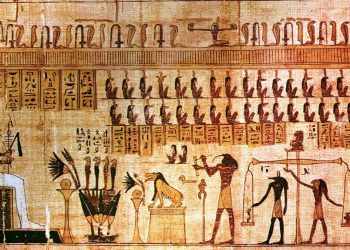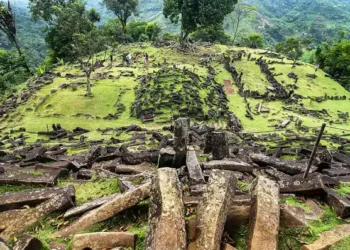With a base area less than a quarter of that of the Pyramid of Khufu and Khafre, having an original height of around 66 meters, the Pyramid of Menkaure represents one-tenth of the building mass of the Great Pyramid of Giza, built by Menkaure’s grandfather Khufu.
Although the smallest of the three pyramids at the Giza plateau, the pyramid of Menkaure is fascinating for a number of reasons.
Called “Menkaure is divine” the pyramid of Menkaure has a base area of 102.2 by 104.6 meters (335 ft × 343 ft) or 200 cubits (original). Constructed of limestone and granite, the pyramid is unique as its first sixteen courses were made of red granite, giving the pyramid a distinctive appearance.
The last, great Pyramid of Giza
The reason why the size of the pyramid is much smaller compared to Khufu’s and Khafre’s may be related to the general area of the Giza plateau. Archeologists argue that the ancient builders simply did not have enough room to build another massive pyramid at the plateau.
Another reason as to why Menkaure’s pyramid was so smaller may be related to the pyramid’s temple complex. Researchers say that Menkaure may have placed more emphasis on temples and their endowments and less on the pyramid as the marker of his personal tomb.
This idea, say Egyptologists, can already be traced back to the reign of Menkaure’s father, Khafre, the man who supposedly also commissioned the Sphinx to be carved. This emphasis is believed to have continued throughout the Old Kingdom.
As pyramids shrank in size and were made out of less durable materials, mortuary temples grew and were expanded in both size and complexity, resulting in much more intricate and elaborate structures.
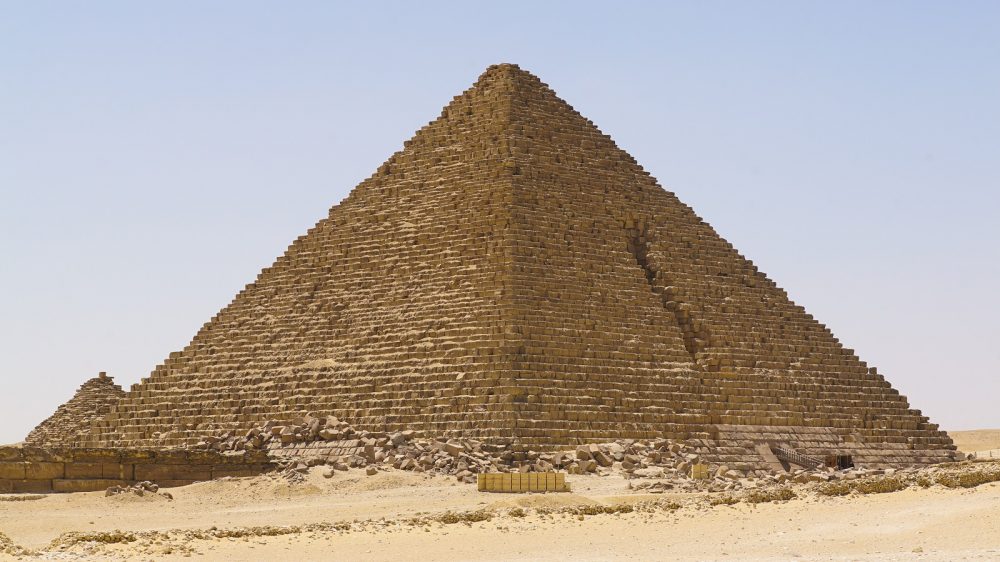
But despite the relatively smaller size of the pyramid, the builders still created a complex pyramid, using a great amount of granite which was much more costly t quarry and transport compared to much softer limestone.
This is indicative of the fact that although Menkaure greatly placed emphasis on his pyramid temple, he wanted to build a durable and unique pyramid.
The interior of Menkaures’ pyramid was similar to other pyramids. The original entrance to the pyramid is four meters above the base of the northern side of the structure.
From there, a descending passage leads down around 32 meters where a horizontal chamber was built. There, a series of panels carved with a repeated, tall and stylized false door motif remain.
In fact, this is quite unique as it is the first purely decorative element within a pyramid since the Step pyramid of Djoser.
From the horizontal chamber, a horizontal passage takes us to a rectangular antechamber inside the pyramid, oriented east-west. The builders constructed the east-end directly beneath the vertical axis of the structure.
From there, a passage opens in the wall of the chamber located above the point where the horizontal passage enters. It leads to nowhere: after a short horizontal section, the passage slopes into, and ends in the core of the pyramid. This is probably part of an abandoned structure within the pyramid.
This passage may have been abandoned when the builders lowered the floor of the antechamber.
A short passage slope from the middle of the floor of the antechamber and takes us down to the room identified as the burial chamber. The burial chamber of Pharaoh Menkaure was constructed inside a rectangular space which was carved directly out of the bedrock and encases in granite.
Inside the Pyramid
By the time mainstream scholars entered the chamber, its contents were already–supposedly–looted. The lid of the sarcophagus was missing, and the scattered bone fragments of a male were discovered in the upper chamber.
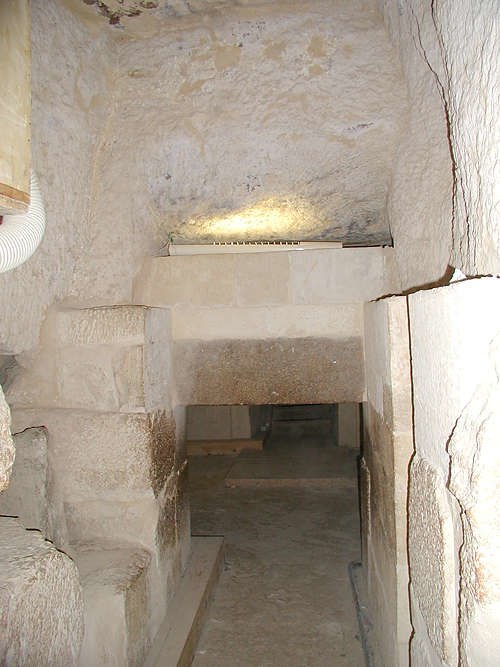
The sarcophagus, thought to have belonged to Pharaoh Menkaure, was lost at sea when the ship Beatrice sank as it was transporting it from Egypt to England. However, it was recorded that the sarcophagus contained a strange wooden coffin that was supposedly inscribed form Menkaure. Strangely, the style of the coffin dates not to the time of Menkaure, but to the Saite period at the very earliest.
Just as many of the other mysteries discovered inside pyramids, the bones recovered by experts from the upper chamber inside Menkaure’s pyramid date back to the Christina period.
This means that Menkaures’ mummy is nowhere to be found, just as the mummy of Khufu and Khafre is missing.
Facts
The exact date when the pyramid of Menkaure was built remains a profound mystery since there are no ancient texts that mention its purpose or construction. Nonetheless, Egyptologists argue that the pyramid was most likely completed around 2,500 BC, during ancient Egypt’s Fourth Dynasty. The competed pyramid’s total volume was 235,183 cubic meters (8,305,409 cu ft). Its original height was 65 meters or 200 cubits. The name of the Pyramid is thought to have been “Menkaure is Divine.”
The exact age of the pyramid is shrouded even further in mystery since Egyptologists have still not managed to accurately define Menkaure’s reign.
Despite the fact that the pyramid Menkaure commissioned was not as impressive as the other two large pyramids at Giza, the temple complex he built was far more grandiose than that of the Great Pyramid. Mortuary temples were usually separate, yet connected structure placed adjacent to the Pharaoh’s tomb.
The Pyramid features a massive, vertical opening no the northern side. This was created after an attempt to destroy the Pyramids at Giza, starting with the smallest one by Al. Malik Al-Azizi Osman bin Salahadin Yusuf, in the late 12th century. The workers hired by Al-Aziz remained at the pyramid for 8 months but eventually found it too difficult to demolish. According to reports, they could only remove ONE or TWO stones a day.
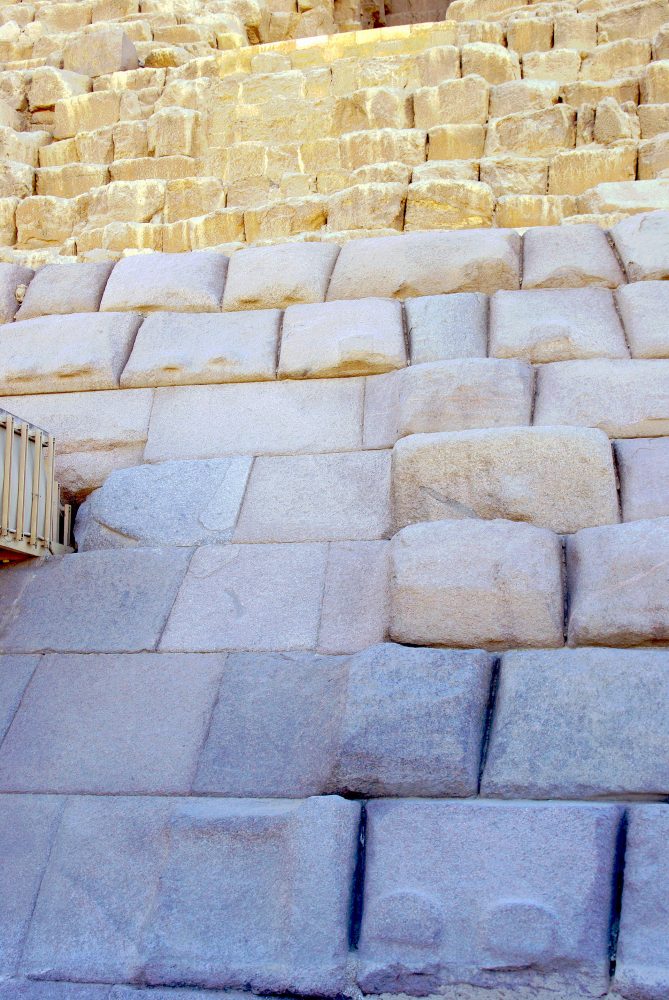
The Pyramid of Menkaure demonstrates the builder’s haste. The workers are thought to have built the pyramid in various phases a fact clearly visible due to the various materials and various techniques recognized at the pyramid. Although the total volume of Menkaure’s pyramid does not exceed a total volume of 250,000 m³–one-tenth of that of Khufu– it features stone blocks much larger even than that of Khufu’s pyramid.
The faces of Menkaure’s pyramid have imperfect surfaces and the stones seem to be arranged to lack the harmony of the other two Giza pyramids. Originally, the pyramid was supposed to have been completely covered with the spectacular red Aswan granite, but the premature death of Menkaure is believed to have caused the builders to use white Tura limestone instead.
Although the sarcophagus from inside the King’s Chamber of the pyramid was lost to sea when the ship Beatrice san on October 13, 1838, between Malta and Cartagena, on the way to Great Britain, the lid of the sarcophagus survived and can be seen today at the British Museum.







